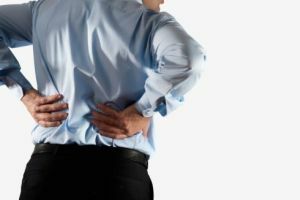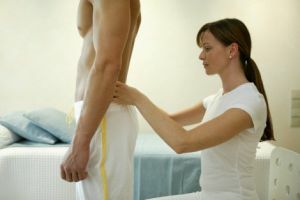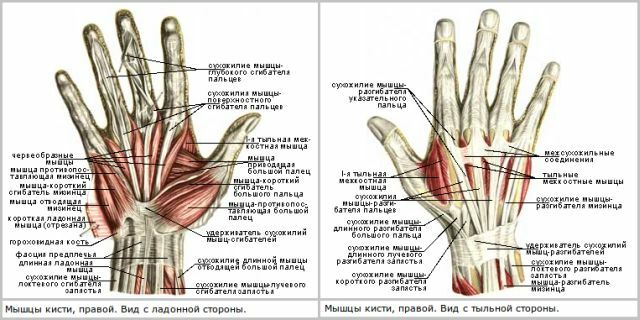
Vertebrogenic lumbosciagia - pain syndrome , provoked by problems in the lumbosacral part. With this syndrome, it is characteristic that the pain "gives" to one or both legs.
Often the pain arises unexpectedly, it is standard - only on one side of the lower back, less often - on both sides.
It is also not often observed pain in the buttock or pain in the hip joint.
After 7 days, it begins to spread in the foot, because of which it is difficult to straighten the sick limb to the end.
Even in a stationary position, the injured leg is almost always exposed or set aside - the person tries not to load it.
Contents of the article
Causes and risk factors
Causes and risk factors
The main reasons that vertebrogenic lumboscialgia can be caused are awkward movement, lifting too heavy objects. However, it is also possible to provoke the appearance of such a lesion:
- persistent stress and depression;
- disorders of posture due to pregnancy, excess weight;
- deforming osteoarthritis;
- hernia of the vertebral disc;
- heavy physical work or individual sports;
- age after thirty years.
Types of pain
Acute lumboscialgia is:
- Reflected pain, which is based on irritation of pain receptors of ligaments, capsules of vertebral joints and other tissues of the spine, muscle spasm.
- Radicular pain caused by involvement of the spinal root, which is characterized by its squeezing, inflammation, edema and demyelination.
The radicular pain is usually stronger, the than the reflex, often has a shooting or piercing character, gives to the interior of the region,  innervated by this spine, is accompanied by numbness and paresthesias, prolapse of tendon reflexes, weakness of muscles in this part.
innervated by this spine, is accompanied by numbness and paresthesias, prolapse of tendon reflexes, weakness of muscles in this part.
At the age of 30-50 years, the hernia of the disc is often the cause of the lesion, in the older age an important role is played by other degenerative changes that cause narrowing of the aperture between the vertebrae.
The cause of non-pain is spondylarthrosis, myofascial syndrome, which involves the muscles of the buttocks, arthrosis of the femoral joint.
Vertebrogenic lumboscialgia can be caused by periarthritis of the hip joint. Acute pain in the lower back and legs can also be the result of exfoliating aortic aneurysm, pancreatic and rectal disorders, gynecological diseases, spondylitis, purulent epiduritis, fracture due to osteoporosis or spinal cord injury by metastases.
Chronic vertebrogenic lumboscialgia can occur with the participation of three pathophysiological components: nociceptive, neuropathic and psychogenic.
In reality, all forms are rarely observed separately. Often there is a combination of them in different versions. Basically, hurts the back and gives a leg from either side, although sometimes the process is two-sided.
Pain localization
The localization of pain and its character in lesions are not unambiguous. The pain may be aching or burning, strong or weak, appearing in the lower back or leg. The pain differs significantly in form, while each form has its own manifestations.
Vertebrogenic lumboscialgia can be observed on the right and left, and also is bilateral.
For the muscular form of the pain, the spasms of the muscles in the lower back are peculiar, from which the mobility in this part strongly suffers, the curvature of the spine may begin.
In vegetative-vascular form, burning pain is observed, which is combined with numbness of the diseased leg. It can be paler than healthy, it will seem cold when touched. There may be a feeling of heat or chilliness, which may be due to increased vascular tone.
Pain of this shape can also be when the body position changes.
The neurodystrophic form is one of the most common. It is characterized by burning pain, with the pain increasing at night. Often observed and trophic changes - thinning of the skin of the affected part.
 Why is it so difficult sometimes to choose comfortable orthopedic insoles for flatfoot you can find out in our article.
Why is it so difficult sometimes to choose comfortable orthopedic insoles for flatfoot you can find out in our article.
How and what to treat polyarthritis on the hands - the question is ambiguous. We tried to give a detailed answer to this question.
Symptomatology and diagnosis
Diagnosis is established with the available radiographic confirmation of the pathological process in the lower back, as well as a detailed clinical picture, including such symptoms:
- back pain, giving off to one or both legs;
- tension of the muscles of the waist;
- cramps in the legs;
- numbness and crawling sensation in the legs;
- weakness in the legs with severe pain syndrome;
- Restrictions of body torsions in the lower back;
- need to get out of the lying position with the support of the hands.
Diagnosis of the disease should include complete neurological examination.
Neurological examination confirming the presence of lumbosciagia may also reveal radiculopathy, the presence of which is an indication for a neurosurgeon's consultation.
Diagnosis is based on complaints of the patient, examination and subsequent diagnosis, which makes it possible to determine the degree of lesion of the lumbosacral portion.
For the diagnosis, data is required:
- of the lumbar and pelvic radiographs;
- computed tomography;
- magnetic tomography of the spine.
Treatment of pain syndrome
If the disease is diagnosed, the main conservative treatment is exercise therapy.
Therefore, almost always patients are prescribed rest, non-steroidal anti-inflammatory drugs, pain relievers, muscle relaxants.
As under the prescription of the doctor, therapeutic blockades and physiotherapeutic procedures can be performed. In some cases, reflexotherapy is also used.
After the acute period ends, the goal of treatment is the restoration of the muscles of the back and ligaments.
Therefore, the basis of conservative treatment is special gymnastics and massage. It is possible to use manual therapy, but it is not used during the acute form of the disease, especially in the situation when the cause of the pain is the squeezing of the roots of the nerves.
It should be borne in mind that lumbago with sciatica is not a disease, it's just a pain syndrome, provoked by a violation.
Not radicular disorder subsides in 3-6 weeks, radicular after 6-8 weeks.
Treatment of chronic abnormalities requires a special approach. In this situation, the doctor must exclude the dangerous causes of pain - infection, osteoporosis, tumors. In this situation, the treatment will be aimed mainly at increasing the motor capabilities of the patient. The most commonly used non-medicinal methods - exercise therapy, massage, weight reduction, etc. The main task is to restore the muscles of the back and the press. In addition to the  , the patient must develop a new stereotype of movement, he must avoid the movements that cause pain.
, the patient must develop a new stereotype of movement, he must avoid the movements that cause pain.
Surgery for lesions is not routinely required, 90% of patients are cured after conservative treatment.
The operation may be necessary only in certain cases.
For example, with a pain syndrome that can not be neutralized by conservative treatment. Also, the operation must be carried out when squeezing the "horse tail", which causes irregularities in the work of the pelvic organs.
Prevention
In order not to cause relapse of the disease, one should follow simple advice:
- try not to stand for a long time;
- if the legs are quickly tired, then lean on the support;
- to give up heels;
- if the work is sitting, then you should sit straight with a roller under your back and rest more often - get up, walk, warm up;
- the same is true if you drive a lot on the machine;
- quit smoking;
- get rid of excess weight;
- the first manifestations of an exacerbation - an occasion to contact a doctor.
Conclusions
The true cause of the disorder is osteochondrosis, the clinical picture accompanying pain does not change, but the mechanisms of the development of the pain syndrome differ significantly depending on which link of pathogenesis is involved in this or that situation.
Such a variety of pathological mechanisms significantly complicates the diagnosis and development of effective treatment algorithms.



